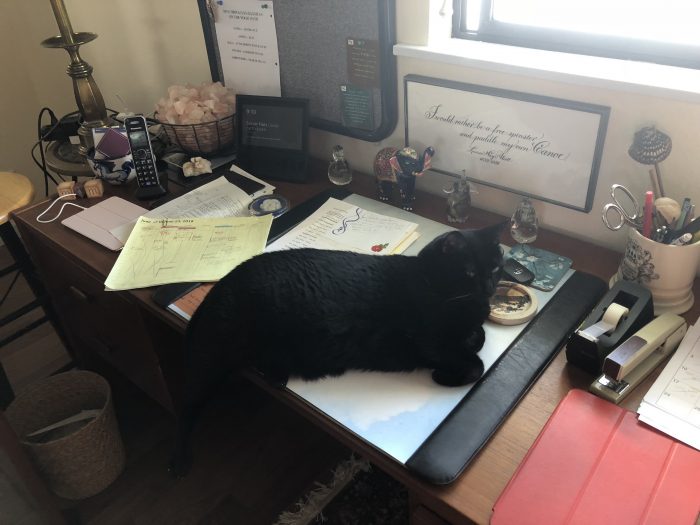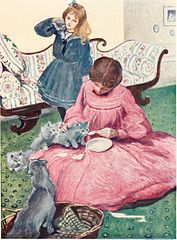
Like many writers, I have a feline writing buddy. And what better time to talk about feline attributes than in Adopt a Cat Month. The American Humane Association adopted the slogan in 1975 as a response to the many kittens dropped off in animal shelters in the spring and summer months.
Cats didn’t always have an invitation to live inside the house, but after the invention of kitty litter in 1947, cats rapidly made inroads as the favored American companion pet, presently outnumbering dogs three to one. There are approximately 90 million domestic house cats residing in 34 percent of American homes. The most recent statistics (2024) provided by World Animal Foundation state there are between 6.02 and 62 million pet cats in the U.S.

Researchers have documented the social benefits of owning a cat. [I find it interesting that research funding is available for these studies.] In short, unless we have an allergy, cats are good for us. They provide companionship, albeit on their own terms. Petting a cat lowers stress levels and blood pressure for both cats and humans, and cats can be fun to have around.
Not everyone likes cats, and there are some downsides to living with a cat, among them changing the litter box and lots of fur during shedding season. Neither of these issues came up until we let cats live inside the house.

Cats and humans have a long history together, mostly good for both species. Ancient Egyptians associated cats with Bastet, a warrior goddess who was half cat and half woman.
Modern domestic cats descend from a Middle Eastern wild cat, Felis sylvestris (Cat of the Wild.) The cats ate rodents, birds, and other small creatures. As humans developed agriculture and began storing grain, mice came looking for food. When cats realized how easy it was to hunt near human settlements, they came too, creating a mutually beneficial working relationship.

Ships’ crews brought cats on board to provide rodent control, thereby spreading cats throughout the world
When Mark Twain visited Hawai`i in 1866, he commented on the cat population which had grown considerably since Captain Cook firsrt made landfall in 1778. Twain observed “platoons of cats, companies of cats, regiments of cats, armies of cats, multitudes of cats.” Today feral cat colonies exist on all the Hawaiian islands.
FELINE EXPRESSIONS
Cat contributions permeate popular expressions. For example: “Getting ______ to ______ is like herding cats” This is a popular saying in business. So, when Electronic Data Systems wanted to demonstrate its ability to do the impossible, they hired Fallon to make them a commercial for Super Bowl XXXIV.
The commercial used real cowboys and about 50 real cats, with the herd scenes augmented by computer. There was one trainer for every five cats. I don’t know if the commercial generated any new business, but it’s fun to watch.
Well Known Cat Sayings
Cats lend themselves to many other popular sayings. “Don’t let the cat out of the bag,” especially when a surprise is involved.
“Cat got your tongue?” really means “Don’t you have something to say?” One possible source of the saying is an ancient Egyptian punishment that entailed cutting out the perpetrator’s tongue and feeding it to a cat.
The saying I heard most often as a child was: “Curiosity killed the cat,” usually said when I asked annoying questions. My parents stopped using it when I discovered the rest of the rhyme: “but satisfaction brought it back.”
Cats in the Wild
Feral cats are a less charming aspect of the feline community. Cats are omnivorous, and homeless cats prey on whatever food is available, including native birds and insects. Bird enthusiasts point out that cats annually kill 2.4 billion birds in the U.S.
But their hunting instincts can be put to good use. The city of Chicago had a burgeoning rat population. In partnership with the Tree House Humane Society, the city launched the Cats at Work Project in 2002. They found that even if the cats didn’t directly kill the rats, the scent cats left marking their territory caused rats to leave the area. In 2017 the Washington D. C. Humane Rescue Alliance launched the Blue Collar Cats program with similar results.
???
Illustrations
My Cat. Photo by Author.
The Cat, 1905 by Violet Hunt.
Goddess Bastet by Gunawan Kartapranata.
My Cat has Caught a Rat. Woodblock Print.
“The Health Benefits and Risks of Pet Ownership.” Harvard Health Letter. Feb. 2016.
Kathy Benjamin and Austin Thomson. “10 Scientific Benefits of Being a Cat Owner.” Mental Floss. May 31, 2017
David Zax. “A Brief History of House Cats.” Smithsonian. June 30, 2007.

Sandra Wagner-Wright holds the doctoral degree in history and taught women’s and global history at the University of Hawai`i. Sandra travels for her research, most recently to Salem, Massachusetts, the setting of her new Salem Stories series. She also enjoys traveling for new experiences. Recent trips include Antarctica and a river cruise on the Rhine from Amsterdam to Basel.
Sandra particularly likes writing about strong women who make a difference. She lives in Hilo, Hawai`i with her family and writes a blog relating to history, travel, and the idiosyncrasies of life.


I like the story about feline or cat…so amazing..here cats are treat as a pet..i am referring here in the philippines..i love cats but sorry to say we don’t have any cats at home…thanks to this story…enables me more to love cats..thanks ma’am sandra for this blog…next time again…send me more writings of yours…